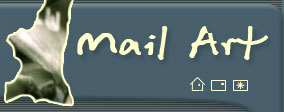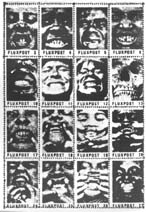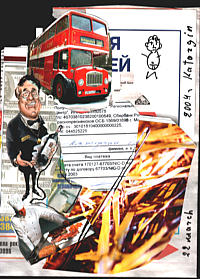 |
 |
Mail art is art which uses the postal service as a medium.
Whether or not one is a formal mail artist, there exists a rich history of creative products sent through the post to draw upon. The most familiar example is the illustrations on envelopes carrying first day issue postage stamps, which philatelists refer to as first day covers, but mail art encompasses other "decorated envelopes" as well as a wide range of other procedures and media such as rubberstamping and the creation of artistamps. Mail art is traditionally, though not always, distinguished from simply "mailed art," which is art that does not truly use the postal service but is simply regular art when sent through the mail. There is a common legend that mail art began when Cleopatra had herself delivered to Julius Caesar in a rolled-up carpet. However, perhaps the initial genesis of mail art was in postal stationery, from which mail art is now typically distinguished (if not defined in its broadest sense). The first example of postal stationery was the pictorial design created by the English artist William Mulready (1786-1863) for mass printing-press reproduction on the first stock of prepaid postage wrappers or envelopes produced for the launch of the Penny Post in Britain in 1840. Mulready's design was not well-received by the public and various cartoonists and artists produced lampoon versions. However it was recognized that an innovative and powerful communication adjunct piggybacking on the basic letterpost service had become available, and over the next 50 years or so millions of pictorial envelopes with a wide variety of motifs and designs were processed by postal services worldwide. As an art form the early genre produced low- and high-minded works ranging from the comic and satirical through commercial and industrial advertising to the promotion of socially worthy causes such as free trade, world peace and brotherhood, and the abolition of slavery. Examples exist of pictorial propaganda envelopes with patriotic motifs produced by both sides during the American Civil War. The enthusiastic use of this piggyback medium continued throughout the second half of the 19th century until postal administrations worldwide began to authorize the use of picture postcards, which were first approved and offered for sale at all Post Offices in the Austrian Empire on October 1, 1869. In a sense this was the beginning of the end of the heyday of the
pictorial envelope. Producing a card with an illustration on it,
whether executed by hand or by a mechanical printing process, is
less involved than producing it on an envelope. A card is flat and
usually rectangular like a canvas; an envelope starts out flat,
but the sheet from which it is formed has to be shaped and then
folded. The extra difficulty which producing multiple printed envelopes
entails eventually led to the establishment of the commercial envelope
printing and overprinting industry which, like commercial envelope
manufacture, is perforce an economy-of-scale activity, which means
it is at its most economically efficient when the print run is very
long. This was the situation prevailing until the advent of digital electronics in the late- 1960s/early-1970s. The convergence of this technology with telephone technology led to the development of the social-change engine known as the Internet by the early 1990s, so that by the end of the 20th century it had become increasingly common to find households with a digital computer and a sheet printer. By employing suitable software the printer could be used to customise machine-made envelopes, each with a unique composition of colorful digitised text and graphics. In principle this meant even the most graphically challenged could employ the pictorial or illustrated envelope medium and produce a work categorizable as mail art. Some works, whether or not produced with the aid of a computer, might be constructed with postal distribution in mind; others might make use of the postal service to facilitate a collaboration or work of 'correspondence art' between artists. When the electronic telecommunications network known as the Internet gave rise to e-mail art, conventional mail-art artists came to refer to the international postal service as the 'paper net'. When a group of these artists are in some way linked through their works they are collectively referred to as a Mail Art Network. The Mail-Art Network concept has roots in the work of earlier groups, including the Surrealist and Fluxus artists and the notion of 'multiples' or artworks manufactured as editions. Most commonly, Mail-Art Network artists have made and exchanged postcards, designed custom-made stamps or 'artistamps', and designed decorated or illustrated envelopes.But even large and unwieldy three-dimensional objects have been known to have been sent by Mail-Art Network artists, for many of whom the message and the medium are synonymous. Fundamentally, mail art in the context of a Mail Art Network is a form of conceptual art. It is a 'movement' with no membership and no leaders. The 1980s anarcho-punk duo APF Brigade individually recorded each copy of their first mail-order only cassette release Live Brigade. Each was therefore a unique artifact, and thus could arguably be considered to have been a part of the mail art movement (see also Cassette culture). The International Union of Mail Artists (see external link) is a group of mail-art artists individually practicing in several countries. Anyone can join just by saying so; in this way the group is merely unified conceptually. Mail-art artists were among the first to see and use the networking possibilities of the World Wide Web when it appeared in 1992 to bring graphics to the previously text-oriented Internet. But at the same time, the Internet offered nothing new to them (as it is certainly not possible to send objects over the internet). Mail-art artists, like graffiti and poster artists, often work anonymously or collectively under aliases. Artist Trading Cards or ATCs can also be sent by mail and are actively traded by many mail artists. It is believed that the largest mail art project is Ryosuke Cohen's Brain Cell project, started in 1985. As of 1998, more than 400 issues had been created, with new issues every 8 to 10 days. Created by The Panman (markb@echonyc.com) Mail-artshow
<UP> The "art" is the ongoing exchange between artists, sort
of like a perfomance work or "happening". Mail-art is cross-cultural. It is inclusive of all colors, ages,
languages, sizes, able-bodiedness, and nationalities. (text from Ashley Parker Owens,former editor of the networkermagazine "Global Mail,Chicago,1995,USA)
|

